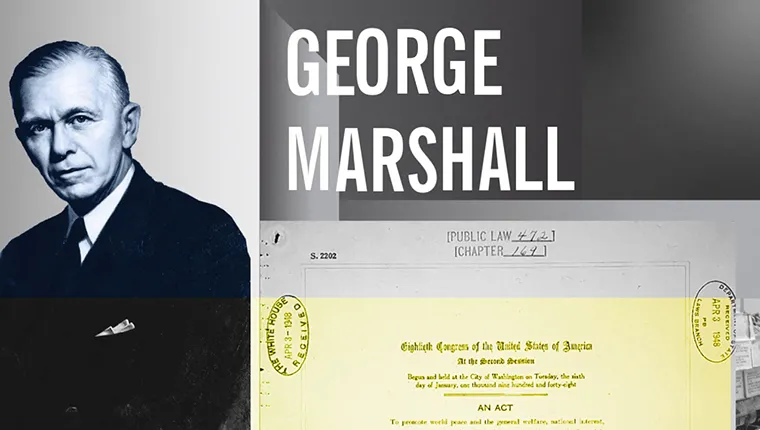The Marshall Plan
Understand how the Marshall Plan, one of the first large foreign aid programs, helped Europe rebuild after World War II, but also served the foreign policy interests of the United States.
After World War II, European countries whose economies had been destroyed turned to the United States for help. And it delivered: to rebuild Europe, the Harry S. Truman administration put together a massive aid package known as the Marshall Plan, the biggest ever of its kind. The economic assistance revitalized Europe’s industries and provided food for millions of people across the continent, but there was another equally important benefit. By providing political and economic stability to European countries, the United States pulled countries closer to it and further away from its Cold War adversary, the Soviet Union. The Marshall Plan is a reminder that aid isn’t just a gesture of kindness—it is a strategic tool that countries use to advance their interests.
Video Transcript: How the Marshall Plan helped rebuild Europe after the Cold War
The United States and Europe after World War II
In 1948, Europe was in shambles. World War II destroyed entire cities, left millions of people homeless, and decimated the continent’s economy. A massive economic, infrastructure and governmental rebuild was in order, and European countries looked to their ally across the Atlantic. The United States had emerged largely unscathed from World War II. In fact, the American economy was booming. The U.S. was selling massive quantities of food and goods to a war-ravaged Europe and creating millions of jobs domestically in export-related industries, which allowed it to create the greatest industrial capacity in the world. Meanwhile, after the war, Europe was struggling to rebuild and afford everything it had been importing from the U.S. At the same time, tensions between the United States and the Soviet Union were brewing. The U.S. government saw an opportunity to address both of these challenges. Under President Harry Truman, the United States came up with an unprecedented aid package to help revive its European allies and former enemies alike.
What was the Marshall Plan?
The Marshall Plan was named after then Secretary of State George Marshall and was one of the largest foreign aid programs ever enacted, sending the equivalent of 135 billion dollars in today’s money to Europe for food, goods, and investment in infrastructure and industry. But this plan was not just meant to be an act of charity. All of this was in the express interest of the United States—both strategically and economically.
What did the Marshall Plan do?
The Marshall Plan gave dollars to cash-strapped European countries, enabling them to rebuild their own industrial capacity. The Marshall Plan also addressed the issue of political security. In France and Italy, stalled agricultural production and shortages of important goods was giving momentum to communist organizers, who tapped into the unrest and organized strikes and protests against the French and Italian governments. This trend greatly alarmed the United States. The CIA issued a report saying that greater danger for the United States lay in the possibility of Western European economic collapse and a communist expansion. The Marshall Plan offered the United States a route to stability. The aid was available to all European countries. But it wasn’t only meant to defuse internal conflicts within countries—it was a strategic attempt to fend off aggression from the communist Soviet Union.
The Soviet Union, communism, and the Cold War
The Soviet Union rejected the American aid, and forced Eastern European countries under its influence to reject the offer as well. But countries in Western Europe received it enthusiastically, and the plan’s popularity swung political opinions to the center, snugly next to the U.S. government, and out of reach of the Soviets. For this reason, the implementation of the Marshall Plan is seen as a defining moment of the early Cold War. Bags of wheat from the U.S. Midwest fed starving Germans, money invested into infrastructure built vast hydroelectric dams across Austria, and funds helped rebuild Italy’s Fiat automobile plant, all the while the United States' greatest fear, communism, was locked out of Western Europe.
Legacy of the Marshall Plan
While the scale of the Marshall Plan hasn’t been copied in the decades since it reshaped the European continent, today it is regarded as a massive success and a blueprint for how foreign assistance can help build countries into vibrant democracies and strong partners.
